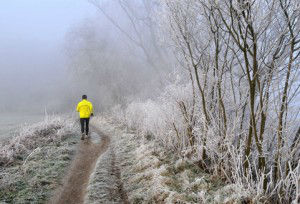
Depending on where you live, the winter months can be a refreshing change to the hot summer sun. Getting outdoors during this time of year can be both invigorating and inspiring (it’s easier to keep going when you’re not drenched in sweat). But just like the summer’s threats of overheating and sunburn, winter exercise comes with its own set of perils to consider.
Before you step out for your daily walk this winter take a look at some of these safety tips that will help keep you out and about all season long.
Warm up. Baby it’s cold outside! To avoid walking too briskly in an effort to generate body heat, which can lead to a strained muscle or a dangerous slip if conditions aren’t right, warm up indoors before heading out. Depending on your fitness level, you may want to march in place for a few minutes or begin with some squats or lunges to get your leg muscles ready to hit the road.
Dress your best. Unlike warmer weather exercise sessions, your sweat won’t be able to evaporate as easily from your skin. Rather, it can get trapped in clothing leaving you wet, cold and downright uncomfortable. Avoid cotton or other absorbent fabrics and invest in clothes designed to wick moisture from your skin. You will also want to consider layering so that as you warm up you can remove outer layers.
Don’t forget your ears, nose and throat! True you’ll want to keep your torso warm, but you’ll also want to keep your head and chest protected too. Earmuffs or a headband are a must and a scarf draped around the neck and chest will add protection from chilly winds. If the air temperature is very cold, loosely layer the scarf around your nose and mouth to lessen the sting of icy air.
Find the Right Footing. If you’re going to be hoofing it out on the sidewalks, be aware of melted snow or puddles which will leave your feet wet and can lead to numb toes or frostbite in more extreme conditions. And watch out for black ice on roadways, a hazard that can quickly lead to a slip or fall.
Wear the right footwear. Proper footwear is important for any exercise session and even more so in winter conditions. Avoid shoes with flat bottoms, especially if you may encounter ice or snow. Hiking or trail shoes with treaded rubber soles will provide extra traction on slick or uneven surfaces.
 See and be seen. The shorter days mean you may be walking in the dark. Carry a light to guide your way or be sure to walk in a well-lit area. And don a reflective vest, belt or ankle bands so drivers can spot you.
See and be seen. The shorter days mean you may be walking in the dark. Carry a light to guide your way or be sure to walk in a well-lit area. And don a reflective vest, belt or ankle bands so drivers can spot you.
What to do in a slippery situation?
- If despite your best efforts you find yourself in the midst of an icy patch don’t panic. Here’s what to do to get yourself off the ice on your feet.
- Keep your head up and don’t lean forward.
- Point your feet slightly out to maintain balance.
- Take very short steps or shuffle like a penguin slowly until you are safely off the ice
-The Alternative Daily
Sources:
http://www.weightwatchers.com/util/art/index_art.aspx?tabnum=1&art_id=239&sc=3040
http://www.prevention.com/fitness/fitness-tips/cold-weather-and-winter-walking?page=2
https://canadasafetycouncil.org/senior-safety/safety-tips-winter-walking
http://www.safety.rochester.edu/safetyinfo/stopwinterfalls.pdf

